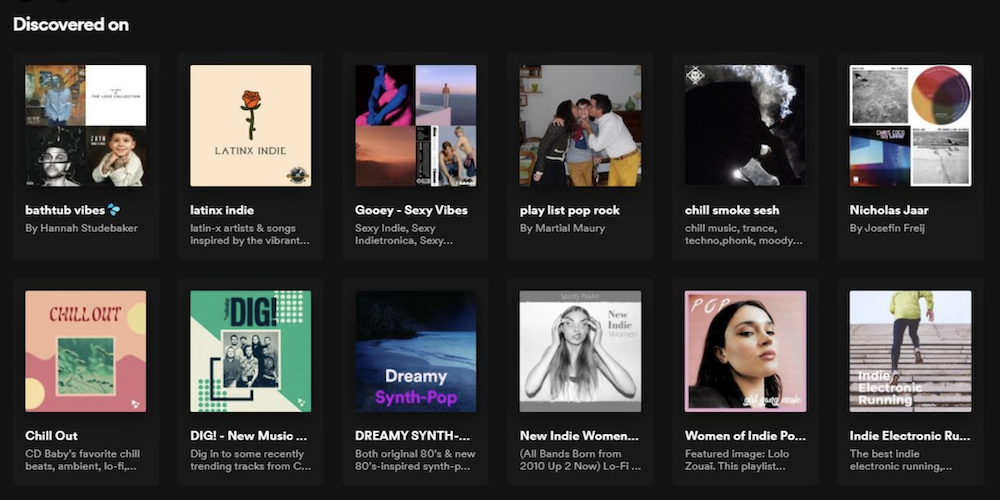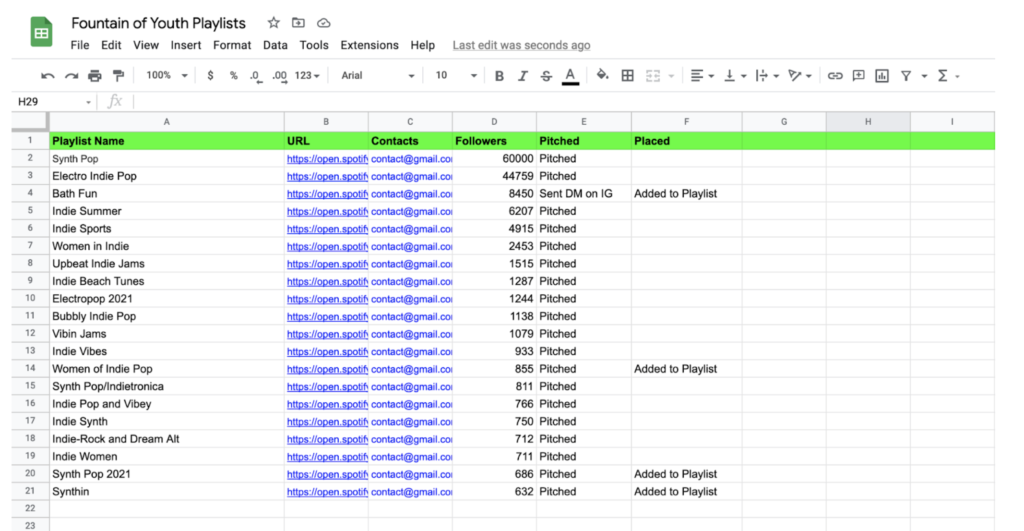How smaller playlists helped me get on an official Spotify playlist.
I’m Cristina. I write and produce music as Siren and the Sea.
I recently released my second album For Bathing and got my songs placed on a bunch of playlists. This helped me go from about 80 monthly listeners to over 1,500.
These were some of the playlists I got placed on:

It’s been awesome to get so much love from my friends, fans, and people I didn’t even know! And getting on these smaller playlists (what some people call “user-generated,” “third party,” or “independently curated” playlists) has been a big part of building my fanbase.
I used to believe that getting on playlists was just about good luck and knowing the right people. It felt rigged and totally impossible for a real indie artist to get on a Spotify editorial playlist.
But I was wrong! I managed to get on an official Spotify playlist with over 100,000 followers.
There was a lot of work that had to happen before that though.
In this article I’m going to share with you the secrets I learned that helped me get placed on all these playlists.
So let’s get into it…
Tip #1 – You have to ASK for playlist placements
Many musicians think that they will get discovered just by uploading new music. Nope.
You need to go find playlist curators and talk to them. Most of them want to connect with artists and hear your new music. You just have to ask.
Of course that’s easier said than done. I was scared to reach out to playlist curators. Rejection sucks.
But if you can confidently present your music, you will end up with way more people supporting you and your music.
Tip #2 – Do your playlist research
I know, we’re musicians. Not scientists. But research is how you’ll build a big list of playlists to pitch your music. And the bigger your list, the more chances you have of getting on hot playlists.
Here’s how I found the right playlists for my music
Step 1: Take good notes
Open up a spreadsheet in Excel, Google sheets, or just use pen and paper.
Step 2: Organize your playlist list
In your spreadsheet, make the following columns: Playlist Name, URL, Contacts, Followers, Pitched, and Placed.
This is my spreadsheet for pitching my single fountain of youth:

Step 3: Describe the playlists
This is really important. You need to categorize your music and come up with keywords that fit your music:
- What genre is your music?
- Who listens to your music?
- What’s the mood?
- Where are you from?
- What are people doing when they listen to your music?
Answering these types of questions will help you search for the right playlists.
I’ll share with you how I categorized my new album, so you have a sense of what to do for your music…
- Genres: Chill synth, Electronic, Neo-disco, Ambient, Synth-pop
- Identity: Female Producer, Latinx, Indie musician
Plus, my album, For Bathing, was meant to be enjoyed while taking a bath. So I looked for any playlists made for taking baths!
Step 4: Search for playlists
Once you have your list of keywords for playlists, it’s time to go find playlists!
Here are two ways you can find playlists:
Option A: Search for playlists directly on streaming platforms.
I spent time searching for playlists on Spotify that had the word ‘Bathtub’ or ‘Chill synth’ or ‘Indie Women’. You can find a lot of stuff if you use the search bar!
Option 2: Search for playlists by using Chartmetric.
Have you heard of Chartmetric?
Chartmetric is a tool that shows you streaming and social media data on musicians, playlists, and more.
You can sign up for a free 7 day trial to check it out. After your trial ends, they do have a free tier for DIY artists (though some features won’t be available to you at that level).
One thing you should try in Chartmetric is looking up artists similar to you. Chartmetric will display what playlists they’re on. Then…
Step 4B: Add those playlists to your list
Each time you find a playlist, add it to your spreadsheet. And MAKE SURE TO FIND THE CONTACT INFO for the playlist curator.
How?
You’ll be surprised — it’s not too hard to find the contact info for these indie playlist curators. You just have to do a little internet digging.
For example, Spotify playlists will display the full name or username of the playlist curator. You can then search their full name and the playlist name in Google and find them online.
If a quick Google search doesn’t yield results, copy the link the playlist and type that into the search fields in Twitter, Google, LinkedIn, etc.
Serious curators will be sharing links to their playlists, because they’re proud of their efforts. The more they promote their own playlists, the easier it is for you to find them online. From there, you’re just a tweet, email, or DM away!
Step 5: You’re done! Go take a bath and chill.
Once you’ve done the research, you should have a big list of playlists to pitch to. So what’s the trick to pitching your music?
Tip #3 – Keep your pitch short and sweet
You don’t need a magic formula or bribery. Every pitch can be similar as long as it’s relevant. You want to be polite, and ask them to listen to your song.
Here’s an example of what my pitch looked like:
“Hi Playlist curator,
I recently found your Spotify playlist “Electro-Pop Mood” and I love it! I have a new electro-pop song called ‘Fountain of Youth’ that might be perfect for your playlist.
https://open.spotify.com/track/5AcsKRXAF1czCN8oMK1thb?si=9df817ba936c42e5
Let me know your thoughts! Have a great week. – Cristina”
This pitch is pretty simple. You say hi, let them know why you like their playlist, and then ask them to check out your song. You can adopt this formula and use it every time you pitch to a playlist.
Another thing you should know: the link to your music should be on the same platform as the playlist. Like, if you’re pitching to a Spotify playlist, you should then send a link to Spotify.
Why does this matter? You want to make it easy for playlist curators to find you and add you to their playlist. If your song isn’t on their platform yet, they can’t listen and then add you right away. You’d have to get their attention a second time which may be hard.
Tip #4 – Pitch your music to Spotify’s Editorial Team
You never know what might happen!
Spotify editorial playlists are the most followed playlists on Spotify and as a result, they can really help you build your following.
Spotify allows anyone to apply for consideration, but many indie musicians believe they need to be on a label to actually make one of these playlists.
Let me tell you something — this is FALSE!
I know because I got on one of these playlists and I’m an Indie artist. Spotify put me on the Fresh Finds: Latin playlist with over 100,000 followers.
So how did I do it?
Here’s how I got on an official Spotify playlist:
1. I built up my monthly listener count before pitching to Spotify
I released three singles in the months leading up to my album. Releasing singles helped me build buzz and boost my monthly listeners count to about 1,500 before I released the album.
It was only when I released my album that I pitched the music to Spotify. That way, I had a higher monthly listener count when they reviewed my application.
2. Be specific about you and your music in your application
Spotify has a lot of playlists, so your best bet is to help them find the perfect fit for your music.
When you fill out the application, make sure to choose really specific genres for your music. And be clear about who you are and who your music serves. Take the time to provide all the info they ask for: instrumentation, mood, and more.
Whatever is specific to you, make sure to share it! It could make the difference.
You can learn more from this Spotify’s blog article about what they want to see in your application.
Thanks for reading and good luck with your playlist pitching! Feel free to comment below with any tips or stories about your experiences pitching to playlists.
The post 4 Tips for getting placed on playlists appeared first on DIY Musician.


